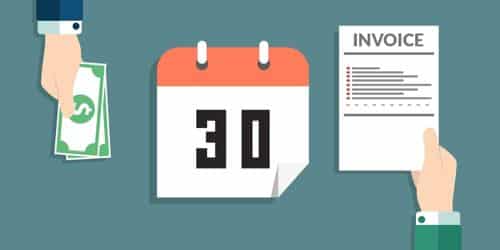When you’re a small business owner, getting paid on time is a top priority. If you don’t set up the right payment terms with your customers, this can lead to late payments, poor cash flow, and unnecessary stress in your business. Fortunately, there are simple steps you can take to improve your billing methods. This article will examine payment terms, their types, examples, importance, and how to use them in your business.
What are Payment Terms?
When you send an invoice to a customer, the payment terms tell them what you expect from them in the future. They let your customers know how you prefer to be paid, and when they need to pay you. The payment terms may also include the consequences of a missed or late payment. In order for your customers to know what to expect, it is important to set up clear payment terms. The easier these are to understand, the easier it will be for your customers to pay you on time.
Why are Payment Terms Important?
Payment terms are important for understanding how much money a business may have available for future projects such as expansion, renovation, new product lines, or advertising campaigns. These terms can specify regular installment payments, which can assist in balancing the required capital for daily and monthly expenses. If business owners understand their monthly cash flow, they may feel less stressed about payments and income.
Who Determines Payment Terms?
Usually, the business owner or head of accounting sets the payment terms for customers before any business is done. This is done so that customers can clearly understand and follow payment terms. When estimating construction and resource costs, a business owner may also decide on payment terms before opening their doors.
Payment Terms Examples
Typically, payment terms are listed as an abbreviation on an invoice. Here are some of the most common examples of payment terms that you should be familiar with.
- 1MD: This represents a payment credit for a full month’s worth of supplies.
- PIA: This abbreviation stands for “payment in advance,” which means that payment must be made in full before the goods or services are delivered.
- CIA: This abbreviation stands for “cash in advance,” which means that the entire payment must be made in cash before the goods or services are delivered.
- Upon receipt: As soon as the client receives the invoice, payment is expected.
- Net 7: means that payment must be made within seven days.
- Net 21: Payment must be made within 21 days of receipt.
- Net 30: Payment must be made within 30 days of the invoice date. Net 60, Net 90, and other variations are also occasionally used.
- End-of-Month (EOM): Payment is due at the end of the month the invoice was received.
- 15 MFI: The 15th of the month following the invoice date is when payment is due.
- 2/10 Net 30: Payment is due in 30 days, but customers can get a 2% discount if they pay in 10 days.
- COD: This stands for “cash on delivery,” which means the goods or services must be paid for in cash at the time of the delivery.
Read Also: Best Online Payment Methods For Small Businesses In 2023
- CND: This abbreviation stands for “cash next delivery,” which means that payment must be made before the following delivery. For recurring deliveries, this payment term is typically reserved.
- CBS: This abbreviation stands for “cash before shipment,” which means that the balance must be paid before the product is shipped to the customer.
- CWO: This abbreviation stands for “cash with order,” which means that the customer must pay the invoice in full before the goods are produced and shipped.
- Accumulation discount: A discount offered on a large order.
Example of How Payment Terms Work
Let’s look at an example to understand why payment terms are so important to your company’s finances:
Assume you’re about to open a new store. You must invest $5,000 in equipment. You recently received a large order from a customer and submitted an invoice for $7,000. Also, you anticipate that the customer will pay the invoice by the end of the month.
However, the customer does not pay on time. As a result, you are unable to purchase the necessary new equipment. You’re now paying rent for your storefront even though you’re not doing any business there. As a result of the late payment, you begin to lose money.
This example demonstrates the importance of timely invoice payments. Putting together a concise, easy-to-understand invoice will go a long way toward ensuring you get paid on time. As a result, you can afford to maintain business operations and achieve your growth objectives.
What Are the Types of Payment Terms?
Companies will sometimes agree to deviate from their standard payment terms and split or combine payments. The most common types of agreements are listed below.
#1. Split Payments
If your business regularly deals with expensive services, luxury items, or large-ticket sales, you should offer split payment options in your invoice term and conditions. Your cash flow is the most valuable asset in your company. Requesting full payment for expensive services or items may turn off clients.
#2. Cash Before Shipments (CBS) & Cash Before Delivery (CBD)
Shipping products can be a risky business, especially if you deliver them over long distances. Your products may be damaged or lost in transit. If you do not take precautions and the customer does not pay, your company may suffer a net loss.
#3. Letter of Credit (LOC)
Customers appreciate companies that give them credit. This is especially common in the business-to-business sector, where you may have recurring purchases from the same clients every few weeks/months. But how can you offer this privilege to customers you’ve never worked with before and have no professional experience with?
#4. Rolling Deposit (RD)
RD is another common method of payment in the B2B sector. If you have any doubts about a customer’s dependability, you can monitor their payments by having them provide a deposit receipt, which acts as a pre-paid secure card they can use to make purchases from you.
#5. 50% Upfront
Some customers may be concerned about requesting a 50% upfront payment, but it greatly smooths over long-term projects. You can cover associated costs without spending money out of your own pocket if you receive a portion of the total price in advance.
#6. NET 30 and NET 60
For customers and new businesses alike, seeing “Net 30” or “Net 60” in an invoice template can be perplexing. In reality, it means that your clients have up to 30 or 60 days after receiving an invoice to make payment. To avoid confusion and potential late payments, replace these terms with “30 days” and “60 days” on your invoices. We still recommend including a specific due date, though.
#7. Discounts
If you want your customers to pay you faster, you should consider implementing a discount system. For example, you could give clients a 1% discount if they pay in full within 7 days of the receipt date, or a 2% discount if they pay the next day. It will save them a little money and you a little gray hair.
How to Use Payment Terms
You can control how and when your customers pay you by using payment terms. These terms establish payment expectations from the beginning, preventing confusion later on.
The following are some pointers on how to take advantage of payment terms:
- Request payment in advance. You might want to request payment upfront in some circumstances. For service providers who want to guarantee payment before starting work, this can be a good option.
- Make a deposit request. Consider requesting a deposit if needing payment upfront isn’t feasible. For larger projects, for example, requesting a 50% deposit is a good option.
- Create monthly retainers. You can set up a monthly retainer for clients with whom you work on a regular basis. You agree to a set monthly payment amount.
- Set the invoice terms. You’ll need to decide on invoice terms if you work for clients on and off. You can, for example, set the invoice terms to be due upon receipt, or you can choose Net 90 payment terms. It all depends on what is best for you and your client.
How to Set Up Effective Payment Terms
If you are having difficulty getting your clients to pay their invoices on time, you may need to implement more effective payment terms. Here are seven suggestions for improving your clients’ payment terms.
#1. Make use of accounting software.
To begin, using accounting software can help you simplify your invoicing process and finances. With the right accounting software, you can send invoices faster and with fewer errors.
#2. State your payment terms clearly.
Before you begin working with a new client, ensure that they understand and agree to your payment terms. Verbally explain the terms to your client, and include a written explanation in the contract you send. This will help to clear up any confusion regarding how much customers owe you and when payment is due.
#3. Be courteous.
Want a simple trick to get your clients to pay you faster? Be courteous when invoicing your clients, and include the words “please” and “thank you” somewhere on the invoice.
#4. Provide multiple payment options.
Have you ever tried to make a purchase at a store only to discover that the store only accepts cash? Consider how you felt when you realized this – were you annoyed and frustrated by the inconvenience?
#5. Set shorter payment terms.
Shortening the due date is one of the most effective ways to get your clients to pay sooner. It may seem obvious, but if you give your clients a long period of time to pay, they will usually accept it.
#6. Be adaptable.
Obviously, you want your clients to pay you on time, but you also need to understand that you’re sometimes working with another company, and that company may be dealing with cash flow issues of its own. Some businesses simply cannot accommodate Net 14 or even Net 30 payment terms and will appreciate more flexible conditions.
#7. Provide a discount for prompt payment.
Consider providing an early-payment discount to your customers. Your standard terms, for example, might be Net 30, but customers get a 2% discount if they pay the invoice within seven days.
How Do You Write Payment Terms and Conditions?
Write payment terms and conditions as follows:
#1. Write the introduction
Highlight the name of your service or product at the top of your terms and conditions document. This is comparable to the first step in learning how to write a business contract. At the top of your terms and conditions and above the contract details, including all affiliates, trade names, subsidiaries, and parent companies.
#2. Describe the terms and conditions.
Write terms and conditions in simple language. Your proposals’ and website’s simple terms and conditions must address all legal issues, ensuring that you are not liable.
#3. Create a statement thanking customers for their business.
Include a customer service acknowledgment statement in your terms and conditions to ensure their validity. For example, the undersigned agrees to the terms and conditions set forth herein.
#4. List the legal owner
Include information about the tasks and actions for which you are not responsible to limit your liability. Make a list of prohibited actions so that the end user is aware of them.
#5. Establish private policy
Another component of your clear terms and conditions is your privacy policy. This section specifies how you intend to handle sensitive customer information. Include information about how to opt out of selling or sharing your information.
#6. Add both parties’ signatures and the dateline
A dateline and space for both parties’ signatures should be included at the end of the terms and conditions.
Importance of Payment Terms
The ability to forecast cash flow, take on new projects, and invest in new opportunities will be made easier by having clearly defined payment terms.
According to a U.S. Bank study, if you are too lax on the payment terms or don’t follow up with customers who have outstanding balances, your business’s cash flow could suffer.
What are the standard payment terms?
Net 10, net 15, net 30, net 60, and net 90 are common forms (also written as net 10 days, etc.). For example, standard payment terms of 30 days could be designated as net 30 or net 30 days, indicating that payment is due on the invoice amount 30 days after the delivery of goods or services.
How Do You Decide Payment Terms for Customers?
When choosing your payment terms, keep in mind the following:
- Investigate each client’s credit history (pull a business credit report if you can).
- Adjust payment terms based on the invoice amount.
- Include clear terms and fees in all contracts and invoices to avoid any misunderstandings about when you should expect payment.
What are the best terms of payment?
Top Payment and Invoicing Terms:
- Payment at the time of service.
- Due upon receipt.
- Deposit required.
- Recurring.
- A 50% deposit is required.
- Cash on delivery (COD)
- Invoice factoring.
Which is the safest payment term?
Letters of Credit
If both parties are willing, this can be one of the safest payment methods for both parties.
What are monthly payment terms?
Payment terms specify how, when, and how your customers or clients pay your company. Typically, invoice payments are subject to payment terms. They are an agreement that establishes your payment expectations, including when the client must pay you and the penalties for late payments.
Conclusion
An essential step in business accounting is setting up an invoicing process with specific payment terms. Payment terms set expectations for your customers and prioritize your payments, resulting in more professional and productive client relationships.
Related Articles
- NET 30 PAYMENT TERMS: Meaning, Examples & Reasons Why You Should Use Them or Not
- ACCOUNTING INVOICE: Definition, How to Record It, and Free Softwares
- What Is Down Payment and How Do You Calculate It?
- HOW TO CREATE AN INVOICE: Best Guide to Create a Standard Invoice
- Invoice Financing: Definition, Types, Pros & Cons






